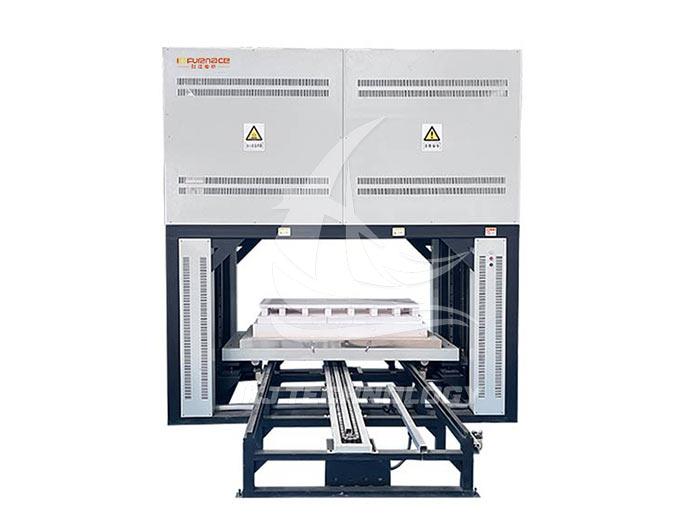Can high vacuum heat treatment electric furnaces be filled with gas?
 09-26-2025 Author: KJ technology
09-26-2025 Author: KJ technology
The high vacuum heat treatment electric furnace can be supplied with gas, but the gas type needs to be selected according to specific process requirements, and precise control can be achieved through a specialized gas control system. The following is a detailed explanation:
1. Gas inlet function of high vacuum heat treatment electric furnace
Design Principles
After the high vacuum heat treatment electric furnace is evacuated to the limit, specific gases (such as inert gas, active gas, or mixed gas) can be filled into the furnace through a gas control system to achieve different process objectives. For example:
Protective atmosphere: Fill with inert gases such as nitrogen (N ₂) and argon (Ar) to prevent oxidation or decarburization of the workpiece.
Chemical heat treatment: Fill with active gases such as methane (CH4) and ammonia (NH3) to perform surface strengthening treatments such as carburizing and nitriding.
Rapid cooling: Fill high-pressure gas (such as nitrogen) to achieve gas quenching and shorten the cooling time.
Gas control method
Electric furnaces are usually equipped with gas mass flow controllers (MFCs), pressure sensors, and solenoid valves, which can accurately control gas flow rate, pressure, and inlet time. Some devices also support staged inflation to meet complex process requirements.
2. Types and uses of gas introduced
Nitrogen (N ₂): prevents workpiece oxidation and is used as a protective atmosphere for annealing, quenching, and other processes. It is necessary to ensure a purity of ≥ 99.99% to avoid oxidation caused by excessive oxygen content.
Argon (Ar): Provides stronger inert protection and is suitable for high temperature or active metal processing. High cost, usually used for processes that require extremely high atmosphere requirements (such as titanium alloy treatment).
Hydrogen (H ₂): A reducing atmosphere used for decarburization, reduction of oxide films, or carburizing processes. It is flammable and requires strict monitoring of concentration and equipped with explosion-proof devices.
Methane (CH ₄): provides a carbon source in the carburizing process and is mixed with nitrogen gas for use. It is necessary to control the decomposition temperature to avoid carbon deposition blocking the pipeline.
Ammonia gas (NH3): provides a nitrogen source in the nitriding process, decomposing into active nitrogen atoms. Corrosive, requiring the use of stainless steel pipes and regular maintenance.
Mixed gases: such as N ₂ - H ₂ mixed gas (used for bright annealing), Ar CH ₄ mixed gas (used for carburizing), to achieve multifunctional processing. Accurate proportioning is required to avoid impurities generated by gas reactions.
3. Operation process of introducing gas
Vacuum pumping stage
First, evacuate to the maximum vacuum degree required by the process (such as 10 ⁻ ³ Pa) to eliminate air and impurities inside the furnace.
Gas filling stage
Inject gas at the set flow rate through a gas mass flow controller (MFC).
Monitor the pressure inside the furnace and adjust the inflation rate through pressure sensor feedback to avoid excessive pressure fluctuations.
Process execution stage
Complete process steps such as heating, insulation, or cooling under gas protection.
Some processes require different gases to be filled in stages (such as nitrogen protection first, followed by methane carburizing).
post-processing stage
After the process is completed, the workpiece can be vacuumed again or filled with inert gas to cool it.
When discharging exhaust gas, it is necessary to use exhaust gas treatment equipment to avoid polluting the environment.
4. Advantages of introducing gas
Control the composition of the atmosphere
Accurately adjust the gas ratio to achieve specific reactions such as oxidation, reduction, carburizing, and nitriding.
Improve process quality
Avoid surface oxidation, decarburization, or hydrogen embrittlement of the workpiece, and improve surface hardness and wear resistance.
Expand the scope of the process
Support complex processes such as vacuum brazing and chemical heat treatment to meet high-end manufacturing needs.
Enhance security
Reduce the risk of flammable and explosive atmospheres through inert gas protection (such as strict concentration control for hydrogen use).
5. Precautions
gas purity
Use high-purity gas (≥ 99.99%) to avoid impurities affecting the process efficiency.
sealing performance
Ensure that the furnace body, pipelines, and valves are well sealed to prevent gas leakage or air infiltration.
safety protection
Flammable gases such as hydrogen require explosion-proof devices and concentration monitoring devices.
Corrosive gases such as ammonia require the use of corrosion-resistant materials and regular inspection of pipelines.
Operating Specifications
Strictly fill the gas according to the process requirements to avoid process failure caused by excessive or insufficient filling.








